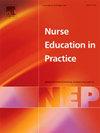增强现实在重症护理教育中的应用:范围综述。
IF 4
3区 医学
Q1 NURSING
引用次数: 0
摘要
目的:本综述旨在确定增强现实(AR)在重症监护病房(ICU)应用的现有文献,并分析其在实践技能方面的现状。背景:积极的学习者参与可以极大地丰富教育成果。随着沉浸式和交互式技术的兴起,AR逐渐融入护理教育中,以增强这方面的能力。尽管AR有潜力,但在ICU护理教育中的应用缺乏证据。设计:根据Arksey和O'Malley框架进行了范围审查。方法:检索Medline、CINAHL、PsycINFO、EMBASE、ERIC、Web of Science 6个数据库,检索时间自成立至今,无语言限制。两名审稿人独立进行选择和数据提取。模式、进展、差距、实践证据和研究建议框架指导数据分析和结果展示。本方案已在开放科学框架注册,注册号:osf.io / 36这件。结果:我们检索了3135篇文章,其中24篇被纳入综述。确定了10项技术产品;微软HoloLens和智能手机分别在8项和5项研究中使用。七项研究使用系统可用性量表(SUS)评估AR应用程序的可用性。他们中的大多数人都表现出了出色的SUS总分。参与者对AR的满意度和信心得到了良好的结果。最后,大多数研究发现在技能和知识表现方面没有统计学上的显著改善。结论:研究结果表明AR具有广泛的可接受性、实用性和可行性,突出了其丰富教育经验的能力。然而,缺乏研究证明AR在ICU教育中的有效性。本文章由计算机程序翻译,如有差异,请以英文原文为准。
Augmented reality in intensive care nursing education: A scoping review
Objectives
This scoping review aimed to identify existing literature on the application of augmented reality (AR) in the intensive care unit (ICU) and analyse its current state of play regarding hands-on skills.
Background
Active learner engagement can greatly enrich educational outcomes. With the rise of immersive and interactive technologies, AR is progressively integrated into nursing education to enhance this aspect. Despite its potential, there is lacking evidence regarding the application of AR in ICU nursing education.
Design
A scoping review was conducted following the Arksey and O'Malley framework.
Methods
Six databases, including Medline, CINAHL, PsycINFO, EMBASE, ERIC and Web of Science, were searched from inception until the present without language restriction. Two reviewers independently performed selection and data extraction. The Pattern, Advances, Gaps, Evidence for Practice and Research Recommendations framework guided data analysis and results presentation. The protocol was registered with the Open Science Framework, Registration No. osf.io/36c25.
Results
Our search yielded 3135 articles, 24 of which were included in the review. Ten technological products were identified; Microsoft HoloLens and smartphones were used in eight and five studies, respectively. Seven studies evaluated the usability of AR applications using the system usability scale (SUS). Most of them demonstrated an excellent overall SUS score. Participants’ satisfaction and confidence in using AR received favourable results. Finally, most studies found no statistically significant improvement in skill and knowledge performance.
Conclusion
The findings demonstrate AR's broad acceptance, utility and feasibility, highlighting its capacity to enrich educational experiences. However, a dearth of research has proved AR's effectiveness in ICU education.
求助全文
通过发布文献求助,成功后即可免费获取论文全文。
去求助
来源期刊

Nurse Education in Practice
NURSING-
CiteScore
5.40
自引率
9.40%
发文量
180
审稿时长
51 days
期刊介绍:
Nurse Education in Practice enables lecturers and practitioners to both share and disseminate evidence that demonstrates the actual practice of education as it is experienced in the realities of their respective work environments. It is supportive of new authors and will be at the forefront in publishing individual and collaborative papers that demonstrate the link between education and practice.
 求助内容:
求助内容: 应助结果提醒方式:
应助结果提醒方式:


